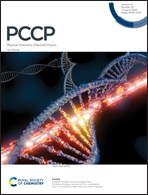Phosphine ligand-coated Cu nanoparticle-catalyzed selective semihydrogenation of alkynes: electronic or hindrance effects of the ligand?†
Abstract
Understanding the mechanism of a catalytic reaction is of fundamental importance not only scientifically but also technologically to the design of high-performance catalysts. In this work, the mechanisms of 1-phenyl-1-propyne and cis-β-methylstyrene hydrogenations catalyzed by Cu55 and ligand-coated Cu55 are explored in detail by means of density functional theory (DFT). The calculated results indicate that the semihydrogenation selectivity of the catalyst can be effectively controlled by employing a suitable ligand. That is, the PCy3 and PPh3 ligands used to coat Cu55 can largely raise the energy barrier of the rate-determining step for cis-β-methylstyrene hydrogenation. By the study of energy decomposition analysis (EDA) and charge density difference, it can be found that the deformation energies of the substrate fragments play a crucial role in the energy barriers of the rate-determining steps. The large hindrance effect of the ligands is beneficial for improving the semihydrogenation selectivity of the catalysts. This study provides significant information for future catalyst design and on the physical origin of the phosphine ligand-coated nanoparticle catalysis for semihydrogenation.



 Please wait while we load your content...
Please wait while we load your content...